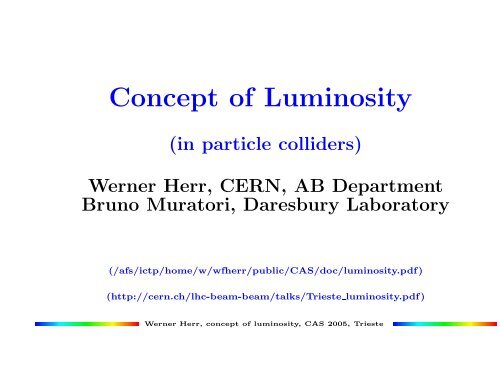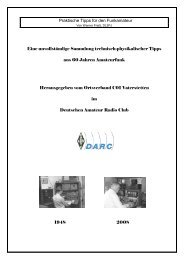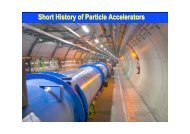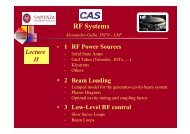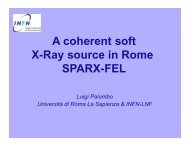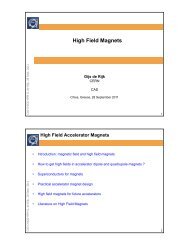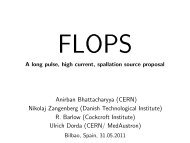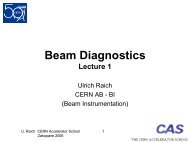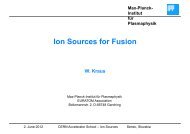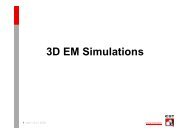Concept of Luminosity
Concept of Luminosity
Concept of Luminosity
You also want an ePaper? Increase the reach of your titles
YUMPU automatically turns print PDFs into web optimized ePapers that Google loves.
<strong>Concept</strong> <strong>of</strong> <strong>Luminosity</strong><br />
(in particle colliders)<br />
Werner Herr, CERN, AB Department<br />
Bruno Muratori, Daresbury Laboratory<br />
(/afs/ictp/home/w/wfherr/public/CAS/doc/luminosity.pdf)<br />
(http://cern.ch/lhc-beam-beam/talks/Trieste luminosity.pdf)<br />
Werner Herr, concept <strong>of</strong> luminosity, CAS 2005, Trieste
Why colliding beams ?<br />
Two beams: E1, p1, E2, p2, m1 = m2 = m<br />
<br />
Ecm = (E1 + E2) 2 − (p1 + p2) 2<br />
Collider versus fixed target:<br />
Fixed target: p2 = 0 Ecm = √ 2m 2 + 2E1m<br />
Collider: p1 = −p2<br />
Ecm = E1 + E2<br />
LHC (pp): 14000 GeV versus ≈ 115 GeV<br />
LEP (e + e − ): 210 GeV versus ?
Collider performance issues<br />
Available energy<br />
Number <strong>of</strong> interactions per second (useful collisions)<br />
Total number <strong>of</strong> interactions<br />
Secondary issues:<br />
Time structure <strong>of</strong> interactions (how <strong>of</strong>ten and how<br />
many at the same time)<br />
Space structure <strong>of</strong> interactions (size <strong>of</strong> interaction<br />
region)<br />
Quality <strong>of</strong> interactions (background, dead time etc.)
We want:<br />
<strong>Luminosity</strong>:<br />
Proportionality factor between cross section<br />
σp and number <strong>of</strong> interactions per second dR<br />
dt<br />
dR<br />
dt = L × σp (→ units : cm −2 s −1 )<br />
Relativistic invariant<br />
Independent <strong>of</strong> the physical reaction<br />
Reliable procedures to compute and measure
dR<br />
dt<br />
Flux:<br />
Fixed target luminosity<br />
=<br />
Φ = N/s<br />
Φ<br />
ρ<br />
L<br />
l<br />
T {<br />
σ p<br />
ρ<br />
T<br />
= const.<br />
l
Collider luminosity (per bunch crossing)<br />
L ∝ K ·<br />
dR<br />
dt = L σp N<br />
ρ (x,y,s,−s )<br />
1 1<br />
0<br />
+∞<br />
−∞<br />
s0<br />
N 2<br />
ρ<br />
2<br />
(x,y,s,s )<br />
0<br />
N particles / bunch<br />
ρ density = const.<br />
ρ1(x, y, s, −s0)ρ2(x, y, s, s0)dxdydsds0<br />
s0 is ”time”-variable: s0 = c·t<br />
Kinematic factor: K = 1/c (v1 − v2) 2 − (v1 × v2) 2 /c2
Collider luminosity (per beam)<br />
Assume uncorrelated densities in all planes<br />
factorize: ρ(x, y, s, s0) = ρx(x) · ρy(y) · ρs(s ± s0)<br />
For head-on collisions (v1 = −v2) we get:<br />
L = 2 · N1N2 · fB<br />
+∞<br />
−∞<br />
dxdydsds0<br />
ρ1x(x)ρ1y(y)ρ1s(s − s0) · ρ2x(x)ρ2y(y)ρ2s(s + s0)<br />
In principle: should know all distributions<br />
Use Gaussian ρ for analytic calculation<br />
(in general: they are a good approximation for<br />
most realistic distributions)
ρiz(z) =<br />
Gaussian distribution functions<br />
σz<br />
ρis(s ± s0) =<br />
1<br />
√ exp<br />
2π<br />
σs<br />
<br />
− z2<br />
2σ 2 z<br />
1<br />
√ exp<br />
2π<br />
<br />
<br />
i = 1, 2, z = x, y<br />
2 (s ± s0)<br />
−<br />
2σ 2 s<br />
For non-Gaussian pr<strong>of</strong>iles not always possible to<br />
find analytic form, need a numerical integration
<strong>Luminosity</strong> for two beams (1 and 2)<br />
Simplest case : equal beams<br />
σ1x = σ2x, σ1y = σ2y, σ1s = σ2s<br />
but: σ1x = σ1y, σ2x = σ2y is allowed<br />
Further: no dispersion at collision point
for σ1 = σ2 → ρ1ρ2 = ρ 2 :<br />
Integration (head-on)<br />
L = 2·N1N2fB<br />
( √ 2π) 6 σ 2 s σ2 x σ2 y<br />
<br />
integrating over s and s0, using:<br />
+∞<br />
−∞<br />
L = 2·N1N2fB<br />
8( √ π) 4 σ 2 x σ2 y<br />
− x2<br />
σ e 2 y2<br />
−<br />
σ<br />
x e 2 − s2<br />
y σ e 2 s e − s2 0<br />
σ2 s dxdydsds0<br />
e −at2<br />
dt =<br />
<br />
π/a<br />
− x2<br />
σ e 2 y2<br />
−<br />
σ<br />
x e 2 y dxdy<br />
finally after integration over x and y: =⇒ L = N1N2fB<br />
4πσxσy
<strong>Luminosity</strong> for two (equal) beams (1 and 2)<br />
Simplest case : σ1x = σ2x, σ1y = σ2y, σ1s = σ2s<br />
or: σ1x = σ2x = σ1y = σ2y, but : σ1s ≈ σ2s<br />
Further: no dispersion at collision point<br />
=⇒ L = N1N2fB<br />
4πσxσy<br />
⎛<br />
⎜<br />
⎝L =<br />
N1N2fB<br />
<br />
2π σ2 1x + σ2 2x<br />
<br />
σ 2 1y + σ 2 2y<br />
⎞<br />
⎟<br />
⎠
Examples<br />
Energy Lmax rate σx/σy Particles<br />
(GeV) cm −2 s −1 s −1 µm/µm per bunch<br />
SPS (p¯p) 315x315 6 10 30 4 10 5 60/30 ≈ 10 10 10<br />
Tevatron (p¯p) 1000x1000 100 10 30 7 10 6 30/30 ≈ 30/8 10 10<br />
HERA (e + p) 30x920 40 10 30 40 250/50 ≈ 3/7 10 10<br />
LHC (pp) 7000x7000 10000 10 30 10 9 17/17 11 10 10<br />
LEP (e + e − ) 105x105 100 10 30 ≤ 1 200/2 ≈ 50 10 10<br />
PEP (e + e − ) 9x3 8000 10 30 NA 150/5 ≈ 2/6 10 10
Crossing angle<br />
Hour glass effect<br />
Complications<br />
Collision <strong>of</strong>fset (wanted or unwanted)<br />
Non-Gaussian pr<strong>of</strong>iles<br />
Dispersion at collision point<br />
δβ ∗ /δs = α ∗ = 0<br />
Strong coupling<br />
etc.
Collisions at crossing angle<br />
ρ 0 ρ<br />
0<br />
(x,y,s,−s )<br />
1<br />
2<br />
(x,y,s,s )<br />
Needed to avoid unwanted collisions<br />
For colliders with many bunches: LHC,<br />
CESR, KEKB<br />
For colliders with coasting beams<br />
Φ
Collisions angle geometry (horizontal plane)<br />
s = − s cos<br />
2<br />
x = x cos φ/2 − s sin φ/2<br />
1<br />
x = − x cos<br />
2<br />
φ/2 + x sin<br />
φ/2<br />
beam 2<br />
φ/2−<br />
s sin<br />
φ/2<br />
x<br />
φ/2<br />
φ/2<br />
beam 1<br />
s = s cos<br />
1<br />
s<br />
φ/2 + x sin φ/2
Crossing angle<br />
Assume crossing in horizontal (x, s)- plane.<br />
Transform to new coordinates:<br />
⎧<br />
⎨<br />
⎩<br />
x1 = x cos φ<br />
2<br />
x2 = x cos φ<br />
2<br />
φ<br />
− s sin 2 , s1 = s cos φ<br />
2<br />
φ<br />
+ s sin 2 , s2 = s cos φ<br />
2<br />
L = 2 cos2 φ<br />
2 N1N2fB<br />
+∞<br />
dxdydsds0<br />
−∞<br />
φ<br />
+ x sin 2 ,<br />
φ<br />
− x sin 2<br />
ρ1x(x1)ρ1y(y1)ρ1s(s1 − s0)ρ2x(x2)ρ2y(y2)ρ2s(s2 + s0)
use as before:<br />
and:<br />
Further:<br />
Integration (crossing angle)<br />
+∞<br />
−∞<br />
+∞<br />
−∞<br />
e −at2<br />
dt = π/a<br />
e −(at2 b<br />
+bt+c)<br />
dt = π/a · e 2−ac a<br />
Since σx, x and sin(φ/2) are small: drop all terms<br />
σ k xsin l (φ/2) or x k sin l (φ/2) for all: k+l ≥ 4<br />
Approximate: sin(φ/2) ≈ tan(φ/2)≈ φ/2
Crossing angle<br />
Crossing Angle ⇒ L = N1N2fB<br />
·S<br />
4πσxσy<br />
S is the reduction factor<br />
For small crossing angles and σs ≫ σx,y<br />
⇒ S =<br />
1<br />
<br />
1 + ( σs<br />
σx<br />
≈<br />
φ<br />
tan )2<br />
2<br />
1<br />
<br />
1 + ( σs<br />
σx<br />
Example LHC:<br />
Φ = 285 µrad, σs = 7.5 cm, S = 0.81<br />
φ<br />
2 )2
d<br />
2<br />
Offset and crossing angle<br />
’<br />
x 1<br />
x<br />
beam 1 beam 2<br />
x<br />
1<br />
x 2<br />
φ/2<br />
x 2 ’<br />
d 1<br />
s 1 ’<br />
s<br />
2<br />
s<br />
1<br />
s ’<br />
2<br />
s
Offset and crossing angle<br />
Transformations with <strong>of</strong>fsets in crossing plane:<br />
⎧<br />
⎨<br />
⎩<br />
x1 = d1 + x cos φ<br />
2<br />
x2 = d2 + x cos φ<br />
2<br />
φ<br />
− s sin 2 , s1 = s cos φ<br />
2<br />
φ<br />
+ s sin 2 , s2 = s cos φ<br />
2<br />
Gives after integration over y and s0:<br />
L = L0<br />
2πσsσx 2 cos2 <br />
φ<br />
2<br />
φ<br />
+ x sin 2 ,<br />
φ<br />
− x sin 2<br />
e − x2 cos 2 (φ/2)+s 2 sin 2 (φ/2)<br />
σ2 x e − x2 sin 2 (φ/2)+s 2 cos 2 (φ/2)<br />
σ2 s<br />
× e − d2 1 +d2 2 +2(d 1 +d 2 )x cos(φ/2)−2(d 2 −d 1 )s sin(φ/2)<br />
2σ 2 x dxds.
Offset and crossing angle<br />
After integration over x:<br />
with:<br />
L = N1N2fB<br />
8π 3<br />
2 σs<br />
A =<br />
sin2 φ<br />
2<br />
σ 2 x<br />
2 cos φ<br />
2<br />
+ cos2 φ<br />
2<br />
σ 2 s<br />
1<br />
−<br />
4σ and W = e 2 (d2−d1)<br />
x<br />
2<br />
+∞<br />
−∞<br />
W · e−(As2 +2Bs)<br />
σxσy<br />
B = (d2 − d1) sin(φ/2)<br />
2σ 2 x<br />
=⇒ <strong>Luminosity</strong> with correction factors<br />
ds
<strong>Luminosity</strong> with correction factors<br />
L = N1N2fB<br />
4πσxσy<br />
· W · e B2<br />
A · S<br />
W : correction <strong>of</strong> beam <strong>of</strong>fset<br />
S: correction for crossing angle<br />
e B2<br />
A : correction for crossing angle and <strong>of</strong>fset
eta function<br />
4<br />
2<br />
0<br />
-2<br />
-4<br />
Hour glass effect<br />
-0.8 -0.6 -0.4 -0.2 0 0.2 0.4 0.6 0.8<br />
Distance from bunch centre<br />
beta at IP: 0.50 m<br />
beta at IP: 0.15 m<br />
β-functions depends on position s
Hour glass effect<br />
β-functions depends on position s<br />
Usually: β(s) = β ∗ (1 + s<br />
β ∗<br />
2<br />
)<br />
i.e. σ =⇒ σ(s) = const.<br />
σ(s) = σ ∗<br />
<br />
(1 + s<br />
β ∗<br />
2<br />
)<br />
Important when β ∗ comparable to the r.m.s.<br />
bunch length σs
Hour glass effect<br />
Take it easy: β ∗ x = β ∗ y, crossing angle, but no<br />
<strong>of</strong>fset<br />
Replace σ by σ(s) in standard formulae<br />
φ <br />
N1N2fB 2 cos +∞<br />
2 e<br />
L =<br />
√<br />
8π πσs −∞<br />
−s2A σ∗ xσ∗ y[1 + ( s<br />
β∗ ) 2 ] ds<br />
A =<br />
2 φ<br />
sin 2<br />
(σ∗ x) 2 [1 + ( s<br />
β∗ ) 2 ] + cos2 φ<br />
2<br />
σ2 s<br />
→ Numerical Integration
Calculations for the LHC<br />
N1 = N2 = 1.15 × 10 11 particles/bunch<br />
B = 2808 bunches/beam<br />
f = 11.2455 kHz, φ = 285 µrad<br />
β ∗ x = β ∗ y = 0.55 m<br />
σ ∗ x = σ∗ y = 16.6 µm, σs = 7.7 cm
Simplest case (Head on collision):<br />
L = 1.200 × 10 34 cm −2 s −1<br />
Effect <strong>of</strong> crossing angle:<br />
L = 0.973 × 10 34 cm −2 s −1<br />
Effect <strong>of</strong> crossing angle & Hourglass:<br />
L = 0.969 × 10 34 cm −2 s −1
Exercise:<br />
If the beams are not Gaussian ??<br />
Assume flat distributions (normalized to 1)<br />
, for [−a ≤ z ≤ a], z = x, y<br />
ρ1 = ρ2 = 1<br />
2a<br />
Calculate r.m.s. in x and y:<br />
< (x, y) 2 +∞<br />
> = (x, y) 2 · ρ(x, y)dxdy<br />
and<br />
L =<br />
−∞<br />
+∞<br />
ρ1(x, y)ρ2(x, y) dxdy<br />
−∞<br />
Compute: L · < x 2 > · < y 2 ><br />
Repeat for various distributions and compare
Lint(s) =<br />
Integrated luminosity<br />
T<br />
0<br />
+s<br />
−s<br />
L(s ′ , t)ds ′ dt<br />
The real figure <strong>of</strong> merit:<br />
Lint(s) · σp = number <strong>of</strong> events<br />
Experiments: continuous recording <strong>of</strong> L<br />
For studies: assume some life time behaviour.<br />
E.g. L(t) −→ L0 exp <br />
− t<br />
τ<br />
Contributions to life time from: intensity decay,<br />
emittance growth etc.
Integrated luminosity<br />
Knowledge <strong>of</strong> preparation time allows<br />
optimization <strong>of</strong> Lint
Integrated luminosity<br />
Typical run times LEP:<br />
tr ≈ 8 - 10 hours<br />
For LHC long preparation time tp expected<br />
Optimum combination <strong>of</strong> tr and tp gives<br />
maximum luminosity<br />
tr is usually a ”free” parameter, i.e. can be<br />
chosen
Maximising Integrated <strong>Luminosity</strong><br />
Assume exponential decay <strong>of</strong> luminosity<br />
L(t) = L0 · e t/τ<br />
Average luminosity < L ><br />
< L >=<br />
tr<br />
0 dtL(t)<br />
tr+tp<br />
= L0 · τ · 1−e−tr/τ<br />
tr+tp<br />
(Theoretical) maximum for:<br />
tr ≈ τ · ln(1 + <br />
2tp/τ + tp/τ)<br />
Example LHC (OB): tp ≈ 10h, τ ≈ 15h,<br />
⇒ tr ≈ 15h<br />
Exercise: Would you improve τ (long tr) or tp ?
Luminous region<br />
2 s<br />
−s +s<br />
Density distribution <strong>of</strong> interaction vertices<br />
Fraction <strong>of</strong> collisions occur ± s from the IP ?<br />
Important for experiments !
Luminous region<br />
Depends on σx, σy, σs and crossing angle φ<br />
Integrate only along a finite longitudinal length:<br />
L0 =<br />
L(S) =<br />
+∞<br />
−∞<br />
L(s ′ )ds ′ −→ L(S) =<br />
N1N2fB<br />
8πσ ∗ xσ ∗ y<br />
2 cos φ<br />
2<br />
√ πσs<br />
+S<br />
−S<br />
π<br />
A erf<br />
L(s ′ )ds ′<br />
√ <br />
A S
Some results for LHC<br />
σs = 7.7 cm, β ∗ = 0.55 m, φ = 285 µrad:<br />
100% lumi → s = ± 12 cm<br />
90% lumi → s = ± 7 cm<br />
80% lumi → s = ± 5.5 cm
Interactions per crossing<br />
<strong>Luminosity</strong>/fB ∝ N1N2<br />
In LHC: crossing every 25 ns<br />
Per crossing approximately 20 interactions<br />
May be undesirable (pile up in detector)<br />
=⇒ more bunches B, or smaller N ??<br />
Beware: maximum (peak) luminosity<br />
Lmax is not the whole story ... !
<strong>Luminosity</strong> measurement<br />
One needs to get a signal proportional to<br />
interaction rate Beam diagnostics<br />
Large dynamic range:<br />
10 27 cm −2 s −1 to 10 34 cm −2 s −1<br />
Very fast, if possible for individual bunches<br />
Used for optimization<br />
For absolute luminosity need calibration
<strong>Luminosity</strong> calibration<br />
(e + e − )<br />
Use well known and calculable process<br />
e + e − → e + e − elastic scattering (Bhabha<br />
scattering)<br />
Have to go to small angles (σel ∝ Θ −3 )<br />
Small rates at high energy (σel ∝ 1<br />
E 2 )
<strong>Luminosity</strong> calibration<br />
¡<br />
¡<br />
¡<br />
¡<br />
¡<br />
¡<br />
¡<br />
¡<br />
¡<br />
¡<br />
¡<br />
¡<br />
¡<br />
¡<br />
¡<br />
¡<br />
¡<br />
¡<br />
¡<br />
¡<br />
¡<br />
¢<br />
¢<br />
¢<br />
¢<br />
¢<br />
¢<br />
¢<br />
¢<br />
¢<br />
¢<br />
¢<br />
¢<br />
¢<br />
¢<br />
¢<br />
¢<br />
¢<br />
¢<br />
¢<br />
¢<br />
¢<br />
¢<br />
¢<br />
¢<br />
£<br />
£<br />
£<br />
£<br />
£<br />
£<br />
£<br />
£<br />
£<br />
£<br />
£<br />
£<br />
£<br />
£<br />
£<br />
£<br />
£<br />
£<br />
£<br />
£<br />
£<br />
¤<br />
¤<br />
¤<br />
¤<br />
¤<br />
¤<br />
¤<br />
¤<br />
¤<br />
¤<br />
¤<br />
¤<br />
¤<br />
¤<br />
¤<br />
¤<br />
¤<br />
¤<br />
¤<br />
¤<br />
¤<br />
¥<br />
¥<br />
¥<br />
¥<br />
¥<br />
¥<br />
¥<br />
¥<br />
¥<br />
¥<br />
¥<br />
¥<br />
¥<br />
¥<br />
¥<br />
¥<br />
¥<br />
¥<br />
¥<br />
¥<br />
¥<br />
¦<br />
¦<br />
¦<br />
¦<br />
¦<br />
¦<br />
¦<br />
¦<br />
¦<br />
¦<br />
¦<br />
¦<br />
¦<br />
¦<br />
¦<br />
¦<br />
¦<br />
¦<br />
¦<br />
¦<br />
¦<br />
§<br />
§<br />
§<br />
§<br />
§<br />
§<br />
§<br />
§<br />
§<br />
§<br />
§<br />
§<br />
§<br />
§<br />
§<br />
§<br />
§<br />
§<br />
§<br />
§<br />
§<br />
x<br />
e+<br />
e−<br />
e+<br />
e−<br />
monitors<br />
Measure coincidence at small angles<br />
Low counting rates, in particular for high<br />
energy !<br />
Background may be problematic
<strong>Luminosity</strong> calibration<br />
(hadrons, e.g. pp or p¯p)<br />
Must measure beam current and beam sizes<br />
Beam size measurement:<br />
Wire scanner or synchrotron light monitors<br />
Measurement with beam ... → remember<br />
luminosity with <strong>of</strong>fset<br />
Move the two beams against each other in<br />
transverse planes (van der Meer scan)
Counting rate<br />
1.2<br />
1<br />
0.8<br />
0.6<br />
0.4<br />
0.2<br />
0<br />
<strong>Luminosity</strong> optimization<br />
Van der Meer scan<br />
-4 -2 0 2 4<br />
amplitude<br />
¡<br />
¡<br />
¡<br />
¢<br />
¢<br />
¢<br />
¢<br />
¢<br />
¢<br />
¢<br />
¢<br />
¢<br />
¢ ¢ £<br />
¢<br />
£<br />
£<br />
£<br />
£<br />
£<br />
£<br />
£<br />
£<br />
£<br />
¤<br />
¤<br />
¤<br />
¤<br />
¤<br />
¤<br />
¤<br />
¤<br />
¤<br />
¤ ¤ ¥<br />
¤<br />
¥<br />
¥<br />
¥<br />
¥<br />
¥<br />
¥<br />
¥<br />
¥<br />
¥<br />
¥<br />
¥<br />
¡<br />
¡<br />
¡<br />
¡<br />
¡<br />
¡<br />
Record counting rates R(d)<br />
as function <strong>of</strong> movement d<br />
Since R(d) is proportional to<br />
luminosity L(d)<br />
Get ratio <strong>of</strong> luminosity<br />
L(d)/L(0)
<strong>Luminosity</strong> optimization<br />
From ratio <strong>of</strong> luminosity L(d)/L0<br />
Remember: W = e<br />
Determines σ<br />
− 1<br />
4σ2 (d2−d1) 2<br />
... and centres the beams !<br />
”beam-beam deflection scans ...” =⇒
Absolute value <strong>of</strong> L (pp or p¯p)<br />
By total rate and optical theorem<br />
(also: luminosity independent determination <strong>of</strong> σtot):<br />
σtot · L = Ninel + Nel (Total counting rate)<br />
lim<br />
t→0<br />
dσel<br />
dt = (1 + ρ2 ) σ2 tot<br />
16π<br />
L = (1 + ρ2 )<br />
16π<br />
(Ninel + Nel) 2<br />
(dNel/dt)t=0<br />
= 1<br />
L<br />
dNel<br />
dt |t=0<br />
<strong>Luminosity</strong> determined from experimental rates
Absolute value <strong>of</strong> L (pp or p¯p)<br />
By Coulomb normalization:<br />
Coulomb amplitude exactly calculable:<br />
dσel 1 dNel<br />
lim =<br />
t→0 dt L dt |t=0 = π | fC + fN | 2<br />
π | 2αem σtot<br />
t<br />
+ (ρ + i)eB 2 | −t 4π 2 4πα2em t2 ||t|→0<br />
Fit gives: σtot, ρ, B and L<br />
Can be done measuring only elastic scattering<br />
(No Ninel needed !)<br />
=⇒ Roman pots
100000<br />
dN/dt<br />
10000<br />
1000<br />
Differential elastic cross section<br />
dN/dt UA4/2 +++++<br />
Fit strong part −−−−−<br />
Fit Coulomb part −−−−−<br />
0 5 10 15 20 25 30<br />
2 −3<br />
t (GeV ) 10<br />
¡ £ £ £¥¤ ¤ ¦ ¦¢§ § ¨ ¨¢© ©<br />
¢¡<br />
Measure dN/dt at small<br />
t (0.01 < GeV ) and extrapolate<br />
to t = 0.0<br />
Needs special optics to allow<br />
measurement at very small t<br />
Measure total counting rate<br />
N + N<br />
el inel<br />
Needs good detector coverage<br />
Often use slightly modified<br />
method, precision 1 − 2 %
Not treated :<br />
Coasting beams (e.g. ISR)<br />
Asymmetric colliders (e.g. PEP, HERA)<br />
Linear colliders (SLC, TESLA etc.)
How to cook high <strong>Luminosity</strong> ?<br />
Get high intensity<br />
Get small beam sizes (small ɛ and β ∗ )<br />
Get short bunches<br />
Get many bunches<br />
Get exact head-on collisions


